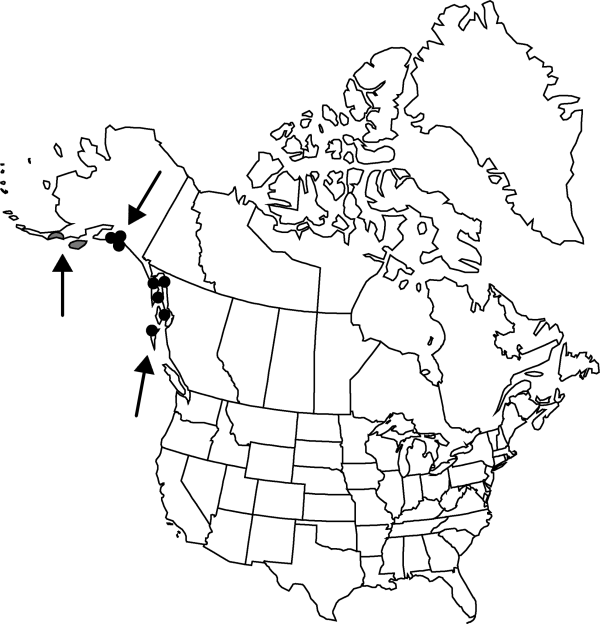Difference between revisions of "Atriplex gmelinii var. alaskensis"
Rhodora 102: 416. 2001.
imported>Volume Importer |
imported>Volume Importer |
||
| Line 65: | Line 65: | ||
|publication year=2001 | |publication year=2001 | ||
|special status=Endemic | |special status=Endemic | ||
| − | |source xml=https:// | + | |source xml=https://bitbucket.org/aafc-mbb/fna-data-curation/src/2e0870ddd59836b60bcf96646a41e87ea5a5943a/coarse_grained_fna_xml/V4/V4_634.xml |
|genus=Atriplex | |genus=Atriplex | ||
|subgenus=Atriplex subg. Atriplex | |subgenus=Atriplex subg. Atriplex | ||
Latest revision as of 21:59, 5 November 2020
Stems sparsely branched, 3–8(–10) dm; branches very stout, obtusely angled, sparsely scurfy when young. Leaves mostly alternate; petiole (0.5–)1–2(–2.5) cm; blade bright green, oblong to lanceolate or hastate-lanceolate or -ovate, 20–90(–125) × 8–60(–70) mm, base rounded to cuneate, with proximal lobe often the largest and antrorse, margin entire or repand-denticulate, apex obtuse or acute, sparsely scurfy when young, becoming more slender and usually entire upwards. Flowers in short, dense, usually leafy, axillary or terminal spikes and in axillary glomerules, staminate ones 4-merous. Fruiting bracteoles sessile, oblong to ovate-orbiculate, or ovate to triangular, sometimes broader than long, 4–14 mm, united only at rounded base, margin entire or with (1 or)2 or more teeth, apex acute or acutish, or sometimes rounded, faces not appendaged, only apex foliaceous. Seeds dark brown (no black seeds observed), 2.8–3.5 mm broad; radicle inferior to subascending.
Phenology: Flowering summer.
Habitat: Coastal salt marsh, with Zostera, Elymus, and other strand and beach plants, from below high-tide level
Elevation: 10 m
Discussion
I. J. Bassett et al. (1983) distinguished this at species level from the closely allied Atriplex gmelinii by sizes of brown seeds, i.e., 1.7–2.7 mm wide, A. gmelinii; and 2.8–3.7 mm wide, A. alaskensis. Some seeds of plants clearly belonging to A. gmelinii bear seeds as much as 3 mm wide, so the distinction in seed size is not absolute. Also, A. gmelinii occasionally bears black shiny seeds, which have not been observed in specimens of A. alaskensis. It is unfortunate that many collections appear to be juvenile plants lacking mature fruiting bracteoles and seeds. The A. alaskensis phase occurs completely within the range of A. gmelinii and might represent no more than a growth phase of the latter species. Certainly there is considerable ecologically induced variation within the gmelinii complex. Plants that grow within the littoral zone, where they are inundated by high tide, present completely different facies than do those that are immediately above the tidal zone. Leaves vary from linear to oblong, oval, and various other shapes within what has been traditionally regarded as A. gmelinii in a strict sense (A. patula var. obtusa). The two entities, var. gmelinii and var. alaskensis, are treated herein as belonging to an inclusive A. gmelinii.
Selected References
None.
